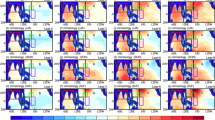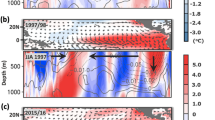Abstract
El Niño’s transitions play critical roles in modulating severe weather and climate events. Therefore, understanding the dynamic factors leading to El Niño’s transitions and its future projection is a great challenge in predicting the diverse socioeconomic influences of El Niño over the globe. This study focuses on two dynamic factors controlling the El Niño-to-La Niña transition from the present climate and to future climate, using the observation, the historical and the RCP8.5 simulations of Coupled Model Intercomparison phase 5 climate models. The first is the inter-basin coupling between the Indian Ocean and the western North Pacific through the subtropical high variability. The second is the enhanced sensitivity between sea surface temperature and a deep tropical convection in the central tropical Pacific during the El Niño’s developing phase. We show that the dynamic factors leading to El Niño-to-La Niña transition in the present climate are unchanged in spite of the increase of greenhouse gas concentrations. We argue that the two dynamic factors are strongly constrained by the climatological precipitation distribution over the central tropical Pacific and western North Pacific as little changed from the present climate to future climate. This implies that two dynamical processes leading to El Niño-to-La Niña transitions in the present climate will also play a robust role in global warming.











Similar content being viewed by others
References
Cai W et al. (2014) ENSO and greenhouse warming. Nat Clim Change 5:849–859 (2014)
Capotondi A et al. (2015) Understanding ENSO diversity. Bull Am Meteorol Soc 96:921–938. https://doi.org/10.1175/BAMS-D-13-00117.1
Chen D et al. (2015) Strong influence of westerly wind bursts on El Nino diversity. Nat Geosci 8:339–345. https://doi.org/10.1038/ngeo2399
Chen W, Lee J-Y, Ha K-J, Yun K-S, Lu R (2016a) Intensification of the western North Pacific Anticyclone response to the short decaying El Nino event due to greenhouse warming. J Clim 29:3607–3627
Chen Z, Wen Z, Wu R, Lin X, Wang J (2016b) Relative importance of tropical SST anomalies in maintaining the western North Pacific anomalous anticyclone during El Niño to La Niña transition years. Clim Dyn 46:1027–1041
DiNezio PN et al. (2012) Mean climate controls on the simulated response of ENSO to increasing greenhouse gases. J Clim 25:7399–7420
Giese BS, Ray S (2011) El Niño variability in simple ocean data assimilation (SODA), 1871–2008. J Geophys Res 116:C02024. https://doi.org/10.1029/2010JC006695
Ha K-J, Yoon S-J, Yun K-Y, Kug J-S, Jang Y-S, Chan JCL (2012) Dependency of typhoon intensity and genesis locations on El Nino phase and SST shift over the western North Pacific. Theor Appl Climatol 109:383–395
Ha K-J, Chu J-E, Lee J-Y, Yun K-S (2017) Interbasin coupling between the tropical Indian and Pacific Ocean on interannual timescale: observation and CMIP5 reproduction. Clim Dyn 48:459–475. https://doi.org/10.1007/s00382-016-3087-6
Ham Y-G, Kug J-S (2014) Effects of Pacific Intertropical Convergence zone precipitation bias on ENSO phase transition. Environ Res Lett 9:064008
Ham Y-G, Kug J-S (2016) ENSO amplitude changes due to greenhouse warming in CMIP5: role of mean tropical precipitation in the twentieth century. Geophys Res Lett 43:422–430
Held IM, Soden BJ (2006) Robust responses of the hydrological cycle to global warming. J Clim 19:5686–5699
Horii T, Hanawa KA (2004) relationship between timing of El Niño onset and subsequent evolution. Geophys Res Lett 31:L06304. https://doi.org/10.1029/2003GL019239
Jin F-F (1997) An equatorial ocean recharge paradigm for ENSO. Part I: conceptual model. J Atmos Sci 54:811–829
Johnson NC, Xie S-P (2010) Changes in the sea surface temperature threshold for tropical convection. Nature Geosci 3:842–845
Kosaka Y, Xie SP, Lau NC, Vecchi GA (2013) Origin of seasonal predictability for summer climate over the Northwestern Pacific. Proc Natl Acad Sci U S A, 110 7574–7579
Kug J-S, Ham Y-G (2012) Indian Ocean feedback to the ENSO transition in a multimodel ensemble. J Clim 25:6942–6957
Kug J-S, Kang I-S (2006) Interactive feedback between ENSO and the Indian Ocean. J Clim 19:1784–1801
Lee S-K, DiNezio PN, Chung E-S, Yeh S-W, Wittenberg AT, Wang C (2014), Spring persistence, transition, and resurgence of El Niño. Geophys Res Lett 41, https://doi.org/10.1002/2014GL062484
Lee S-K et al. (2016) US regional tornado outbreaks and their links to spring ENSO phases and North Atlantic SST variability. Environ Res Lett 11:044008
Lee S-K, Lopez H, Chung E-S, DiNezioi P, Yeh S-W, Wittenberg AT (2018) On the fragile relationship between El Nino and California rainfall. Geophy Res Lett 45:907–915
Lengaigne M, Boulanger J-P, Menkes C, Spencer H (2006) Influence of the Seasonal cycle on the termination of El Niño events in a coupled general circulation model. J Clim 19:1850–1868
Li Y, Lu R, Dong B (2007) The ENSO–Asian monsoon interaction in a coupled Ocean–atmosphere GCM. J Clim 20:5164–5177
Lopez H, Kirtman BP (2014) WWBs, ENSO predictability, the spring barrier and extreme events. J Geophys Res 119:114–138. https://doi.org/10.1002/2014JD021908
McPhaden MJ, Zebiak SE, Glantz MH (2006) ENSO as an integrating concept in Earth science. Science 314:1740–1745
Ohba M, Watanabe M (2012) Role of the Indo-Pacific interbasin coupling in predicting Asymmetric ENSO transition and duration. J Clim 25:3321–3335
Ohba M, Shiogama H, Watanabe M (2013) Impact of strong tropical volcanic eruptions on ENSO simulated in a coupled GCM. J Clim 26:5169–5182
Rayner NA et al. (2003) Global analyses of sea surface temperature, sea ice, and night marine air temperature since the late nineteenth century. J Geophys Res 108:4407. https://doi.org/10.1029/2002JD002670
Stuecker MF, Timmermann A, Jin F-F, Mcgregor S, Ren H-L (2013) A combination mode of the annual cycle and the El Niño/Southern Oscillation. Nat Geosci 6:540–544
Suarez MJ, Schopf PS (1988) A delayed action oscillator for ENSO. J Atmos Sci 45:3283–3287
Taschetto AS, Gupta AS, Jourdain NC, Santoso A, Ummenhofer CC, England. MH (2014) Cold tongue and warm pool ENSO events in CMIP5: mean state and future projections. J Clim 27:2861–2885
Taylor KE, Stouffer RJ, Meehl GA (2012) An overview of CMIP5 and the experiment design. Bull Am Meteorol Soc 93:485–498
Trenberth KE, Branstator GW, Karoly D, Kumar A, Lau NC, Ropelewski C (1998) Progress during TOGA in understanding and modeling global teleconnections associated with tropical sea surface temperatures. J Geophys Res Ocean 103:14291–14324
Tziperman E, Cane MA, Zebiak SE, Xue Y, Blumenthal B (1998) Locking of El Niño’s peak time to the end of the calendar year in the delayed oscillator picture of ENSO. J Clim 11:2191–2199
Wang B, Wu R, Lukas R (1999) Roles of the western North Pacific wind variation in thermocline adjustment and ENSO phase transition. J Meteorol Soc Jap 77:1–16
Wang B, Wu R, Fu X (2000) Pacific-East Asia teleconnection: How does ENSO affect East Asian climate? J Clim 13:1517–1536
Wu B, Li T, Zhou T (2010) Relative contributions of the Indian Ocean and local SST anomalies to the maintenance of the western North Pacific anomalous anticyclone during the El Niño decaying Summer. J Clim 23:2974–2986
Xie S-P et al (2016) Indo-western Pacific Ocean capacitor and coherent climate anomalies in post-ENSO summer: a review. Adv Atmos Sci 33:411–432
Yeh S-W, Wu R, Kirtman BP (2007) Impact of the Indian Ocean on ENSO variability in a hybrid coupled model. Q J R Meterol Soc 133:445–457
Yeh S-W, Kug J-S, An S-I (2014) Recent progress on two types of El Niño: Observations, dynamics, and future changes. Asia-Pac J Atmos Sci 50:69–81
Yu J-Y, Zou Y, Kim ST, Lee T (2012) The changing impact of El Niño on US winter temperatures. Geophys Res Lett 39:L15702. https://doi.org/10.1029/2012GL052483
Yun K-S, Yeh S-W, Ha K-J (2015) Covariability of western tropical Pacific-North Pacific atmospheric circulation during summer. Sci Rep 5:16980. https://doi.org/10.1038/srep16980
Yun K-S, Yeh S-W, Ha K-J (2016) Inter-El Niño variability in CMIP5 models: model deficiencies and future changes. J Geophys Res Atmos 121:3894–3906. https://doi.org/10.1002/2016JD024964
Zhang W et al (2016) Unraveling El Niño’s impact on the East Asian monsoon and Yangtze river summer flooding. Geophys Res Lett 43:11375–11382
Acknowledgements
This study was supported by GRL grant of the National Research Foundation (NRF) funded by the Korean Government (MEST 2011–0021927) and the Institute for Basic Science (Project Code IBS-R028-D1). K. S. Yun was supported by NRF-2015R1C1A1A01054992. S.-W. Yeh was supported by the National Research Fund of Korea Grant funded by the Korean Government (MEST) NRF-2009-C1AAA001-2009-0093042.
Author information
Authors and Affiliations
Corresponding authors
Rights and permissions
About this article
Cite this article
Yun, KS., Yeh, SW. & Ha, KJ. Underlying mechanisms leading to El Niño-to-La Niña transition are unchanged under global warming. Clim Dyn 52, 1723–1738 (2019). https://doi.org/10.1007/s00382-018-4220-5
Received:
Accepted:
Published:
Issue Date:
DOI: https://doi.org/10.1007/s00382-018-4220-5




